In this lesson:
Hello again. This lesson is a follow-up to "Modal Pentatonics Part 1", in which we looked at a way to create interesting new pentatonic scales from each mode of the major scale. If you haven't already checked that lesson out, take a look now to bring you up to speed.
In the lesson we used the 1-3-4-5-7 formula to extract the notes of our modal pentatonics from each mode of the major scale using the same formula that the garden-variety minor pentatonic scale is based upon. For modes 2 (Dorian) and 3 (Phrygian) we got some rather boring results however as the formula just gave us a repeat of the minor pentatonic patterns (see Figures 1, 2, 3 below).
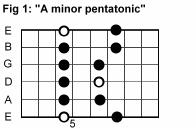
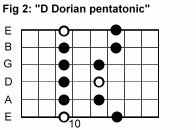
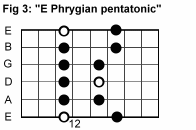
This is where some creativity and a little knowledge about modes come into play. While you can get away with using the patterns above over their respective chords (Am7, Dm7, Em7), I suggest coming up with some substitutions that break away from that 1-3-4-5-7 formula in order to bring out the individuality of certain modes.
Dorian is a great example. While the pentatonic versions of Dorian and Aeolian produce the same pentatonic shapes, the full modes do not. Compare the following:
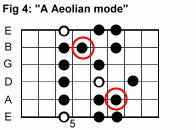
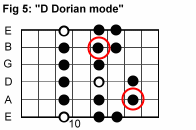
Dorian has a major 6th interval, which produces a different sound to the Aeolian's minor 6th. Since our pentatonic shapes above contain no 6ths at all, a great way to really bring attention to the Dorian sound is squeeze the major 6th interval in somewhere (that'll be a B note when we're talking about D Dorian). I do this by inserting the 6th in place of either the 5th (see fig 6) or the 7th (see fig 7). They both sound cool over a Dm7 chord, but do a good job of spelling out the Dorian sound even without a chord backing it up.
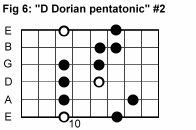
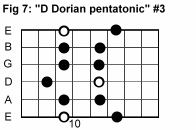
Improving the Phrygian pattern is just as simple; find the note that makes Phrygian different from Aeolian, and work it in somewhere.
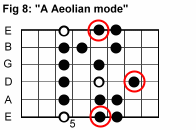
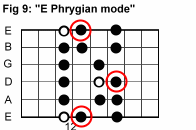
For Phrygian, it's the 2nd that provides a different tonality to Aeolian, so we could highlight the difference replacing one note with another. The ones you choose to replace are really up to your taste; however you feel the mode is defined. Here are some possibilities I often alternate between:
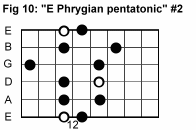
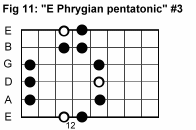
Having greatly improved the modal pentatonics for Dorian and Phrygian by altering that 1-3-4-5-7 formula we started with, feel free to go back through the patterns we created last lesson to see if you can improve upon them. The idea is to create sounds that are personal to you. For example, when we created the C Ionian pentatonic in part 1, we used the notes C (1), E (3), F (4), G (5) and B (7). I rarely use an F note over a C maj7 chord, so I often use the 1-3-5-6-7 pattern as an alternative for Ionian (fig 12). Use the basic formula as a building block, and then feel free to challenge it and personalize it with any of these examples.
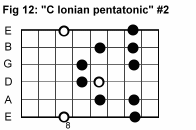
You can nuts with this concept and apply modal pentatonics to all your favorite scales (for example, melodic minor, harmonic minor and their respective modes). The idea is to take the 5 notes you feel are the most important to the sound of the scale, then arrange them in 2-note-per-string patterns so that your picking will be the same as any other pentatonic lick. You can use the formulae used in this lesson or come up with your own variations. Here are some ideas to get you started:
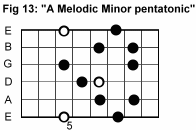
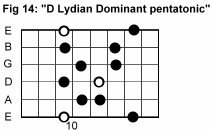
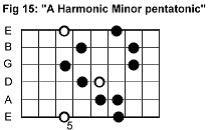
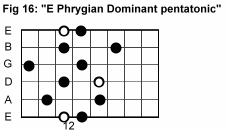
Try your own, and you may end up with some very personalized sounds to add to your soloing style!
A terrific way to use modal pentatonics is to use them in situations where another scale might be the obvious choice. For example, next time you jam over a blues (where major or dominant chords are being used), be sure to try some Mixolydian and Lydian Dominant modal pentatonics mixed in with your normal blues approaches (for example in A, use the A Mixolydian and Lydian Dominant pentatonics over the I chord, D Mixolydian and Lydian Dominant pentatonics over the IV chord, and E Mixolydian and Lydian Dominant pentatonics over the V chord). They provide a great detour from the minor pentatonic and minor blues scales and can sound really whacked out at times - in a good way!
For those shredders out there using Phrygian Dominant (Mode 5 of Harmonic Minor) a lot, the Phrygian Dominant pentatonic may prove to be a great phrasing tool for your solos, but try the Mixolydian pentatonic while you're at it. Increasing your options is what it's all about.
As promised in the last lesson, I've recorded an extended jam using several of the patterns introduced in parts 1 and 2 whilst working in several keys. While I did stray from the patterns quite often to keep things interesting, there are plenty of examples here of the kinds of licks I create using modal pentatonics. Enjoy!
MP3 - Extended Jam
I hope your playing can benefit from some of the ideas in this lesson. Thanks for reading, and feel free to visit my site, drop me a line, and check out my debut disc "The Master Plan".
Chris Brooks is an amazing Australian guitarist setting the instrumental guitar world on fire with his unique brand of progressive metal and fusion.
His instrumental CD is entitled "The Master Plan".